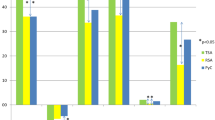Abstract
Reconstruction of the anatomy of the proximal humerus is a prerequisite to achieving good long-term clinical results after shoulder arthroplasty. Modern, adjustable prostheses have greater flexibility of inclination, retroversion, and medial and dorsal offset in comparison with older prostheses. Such improvements should allow for better reconstruction of the centre of rotation compared to older prostheses. Reconstruction of the humeral head centre was assessed in 106 modern adjustable (Affinis) and 47 second-generation prostheses. All reconstructions were compared both to the preoperative state and the unoperated shoulder. To describe the pre- and postoperative states, the geometry and position of the humeral head in relation to the glenoid were analysed on patient radiographs. Applying the defined parameters, modern adjustable prostheses showed better reconstruction than second generation prostheses. Parameter values measured in reconstructions using fourth generation prostheses were comparable to those of the unoperated shoulder, but differed significantly from the preoperative state. Second generation prostheses, in contrast, only show non-specific differences in parameter values. This suggests that an approximate reconstruction of normal anatomy can be achieved using a modern fourth generation prosthesis. Reconstruction of the complex anatomy of the proximal humerus is significantly better with modern adjustable prostheses compared to second generation prostheses. Improved clinical outcome can therefore be predicted in a functional and intact rotator cuff. The advantage of using modern prostheses systems over older models is clearly demonstrated in this study.




Similar content being viewed by others
References
Boileau P, Walch G (1999) Anatomical study of the proximal humerus: surgical technique considerations and prosthetic design rationale. In: Walch G, Boileau P (eds) Shoulder arthroplasty. Heidelberg, Springer Berlin, pp 69–82
Buchler P, Farron A (2004) Benefits of an anatomical reconstruction of the humeral head during shoulder arthroplasty: a finite element analysis. Clin Biomech 19:16–23
Duparc F, Duparc J (2005) Shoulder endoprosthetics. Common principles and important characteristics. In: Duparc F (ed) Techniques in orthopaedics and traumatology [in German]. Urban und Fischer, München, Jena, pp 65–73
Favre P, Moor B, Snedeker JG, Gerber C (2008) Influence of component positioning on impingement in conventional total shoulder arthroplasty. Clin Biomech 23:175–183
Harryman DT, Sidles JA, Harris SL, Lippitt SB, Matsen FA (1995) The effect of articular conformity and the size of the humeral component on laxity and motion after glenohumeral arthroplasty. J Bone Joint Surg Am 77:555–563
Hertel R, Knothe U, Ballmer FT (2002) Geometry of the proximal humerus and implications for prosthetic design. J Shoulder Elbow Surg 11:331–338
Hopkins AR, Hansen UN, Amis AA, Taylor M, Emery RJ (2007) Glenohumeral kinematics following total shoulder arthroplasty: a finite element investigation. J Orthop Res 25:108–115
Iannotti JP, Norris TR (2003) Influence of preoperative factors on outcome of shoulder arthroplasty for glenohumeral osteoarthritis. J Bone Jt Surg Am 85:251–258
Irlenbusch U, Gebhardt K, Rott O, Werner A (2008) Reconstruction of the rotational centre of the humeral head depending on the prosthetic design [in German]. Z Orthop 146:211–217
Irlenbusch U, Irlenbusch L (2007) Update in shoulder endoprosthetics [in German]. Z Orthop Unfallchir 4:289–309
Jeong J, Bryan J, Ianotti JP (2009) Effect of a variable prosthetic neck-shaft angle and the surgical technique on replication of normal humeral anatomy. J Bone Joint Surg Am 91:1932–1941
Jerosch J, Moursi MG, Schunck J (2007) Shoulder resurfacing in patients with degenerative joint disease [in German]. Orthop Prax 43:635–641
Kasten P, Maier M, Rettig O, Raiss P, Wolf S, Loew M (2009) Proprioception in total, hemi and reverse shoulder arthroplasty in 3D motion analyses: a prospective study. Int Orthop 33:1641–1647
McPherson EJ, Friedman RJ, An YH, Chokesi R, Dooley RL (1997) Anthropometric study of normal glenohumeral relationships. J Shoulder Elbow Surg 6:105–112
Nyffeler RW, Sheikh R, Jacob HA, Gerber C (2004) Influence of humeral prosthesis height on biomechanics of glenohumeral abduction. J Bone Joint Surg Am 86:575–580
Nyffeler RW, Gerber C (2004) The relevance of anatomical reconstruction. Nice shoulder course: shoulder arthroscopy and arthroplasty. Current concepts. Sauramps Medical, Montpellier, pp 315–316
Pearl ML, Kurutz S, Postachini R (2009) Geometric variables in anatomic replacement of the proximal humerus: how much prosthetic geometry is necessary? J Shoulder Elbow Surg 18:366–370
Pearl ML (2005) Proximal humeral anatomy in shoulder arthroplasty: implications for prosthetic design and surgical technique. J Shoulder Elbow Surg 14:99S–104S
Pearl ML, Kurutz S, Robertson DD, Yamaguchi K (2002) Geometric analysis of selected press fit prosthetic systems for proximal humeral replacement. J Orthop Res 20:192–197
Pearl ML, Kurutz S (1999) Geometric analysis of commonly used prosthetic systems for proximal humeral replacement. J Bone Joint Surg Am 81:660–671
Roberts SNJ, Foley APJ, Swallow HM, Wallace WA, Coughlan DP (1991) The geometry of the humeral head and the design of the prosthesis. J Bone Joint Surg Br 73:647–650
Thomas SR, Sforza G, Levy O, Copeland SA (2005) Geometrical analysis of Copeland surface replacement shoulder arthroplasty in relation to normal anatomy. J Shoulder Elbow Surg 14:186–192
Walch G, Boileau P (1999) Prosthetic adaptability: a new concept for shoulder arthroplasty. J Shoulder Elbow Surg 8:443–451
Williams GR, Wong KL, Pepe MD, Tan V, Silverberg D, Ramsey ML et al (2001) The effect of articular malposition after total shoulder arthroplasty on glenohumeral translations, range of motion and subacromial impingement. J Shoulder Elbow Surg 10:399–409
Wirth MA, Ondrla J, Southworth C, Kaar K, Anderson BC, Rockwood CA 3rd (2007) Replicating proximal humeral articular geometry with a third-generation implant: a radiographic study in cadaveric shoulders. J Shoulder Elbow Surg 16:S111–S116
Acknowledgements
We would like to thank D. Pfluger and P. Münger for statistical analysis.
Conflict of interest
The independent statistical analysis was supported by Mathys Ltd., Bettlach, Switzerland. UI received consultant payments from Mathys.
Ethics standard
The institutional review board of the Marienstift Arnstadt/Germany has approved the study proposal, and all of the patients agreed by informed consent.
Author information
Authors and Affiliations
Corresponding author
Rights and permissions
About this article
Cite this article
Irlenbusch, U., End, S. & Kilic, M. Differences in reconstruction of the anatomy with modern adjustable compared to second-generation shoulder prosthesis. International Orthopaedics (SICOT) 35, 705–711 (2011). https://doi.org/10.1007/s00264-010-1084-7
Received:
Revised:
Accepted:
Published:
Issue Date:
DOI: https://doi.org/10.1007/s00264-010-1084-7




